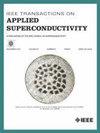Design of Hopfield Networks Based on Superconducting Coupled Oscillators
IF 1.7
3区 物理与天体物理
Q3 ENGINEERING, ELECTRICAL & ELECTRONIC
引用次数: 0
Abstract
The global energy shortage has driven the development of many energy-efficient computational platforms beyond Moore's law, among which brain-inspired neuromorphic computing is one of the promising solutions. Associative memory and pattern recognition are important computations solved by brain-inspired Hopfield networks. Classical Hopfield networks store memories via fixed point attractors of their dynamics. In oscillatory Hopfield networks, these attractors are replaced by periodic orbits. Here, we design an oscillatory Hopfield network based on coupled superconducting oscillators. We first employ a mathematical phase reduction approach to map networks of coupled superconducting rapid single flux quantum (RSFQ) ring oscillators to coupled Kuramoto phase-oscillator networks. We use this theory to numerically optimize the hardware's mutual inductances in order to directly match the phase-reduced superconducting oscillators to a model of phase-oscillator-based Hopfield networks. The resulting network can store multiple oscillatory phase-locked memory patterns and recover the patterns based on the initial phase conditions. As different pattern recognition tasks, or learning, require tunable connectivity strengths between the oscillatory nodes, we further employ a coupler circuit that enables tuning the coupling strength between two oscillators by applying an external flux. We demonstrate the functionality of our design through numerical simulations of a small example network with oscillators operating at 86 GHz and recognizing patterns within 10 ns. Our approach enables the learning and retrieval of dynamical memory patterns with a wide range of applications where rhythmic dynamic output is beneficial.基于超导耦合振荡器的Hopfield网络设计
全球能源短缺推动了许多超越摩尔定律的节能计算平台的发展,其中脑启发的神经形态计算是有前途的解决方案之一。联想记忆和模式识别是脑启发Hopfield网络解决的重要计算。经典的Hopfield网络通过其动态的不动点吸引子来存储记忆。在振荡Hopfield网络中,这些吸引子被周期轨道所取代。在这里,我们设计了一个基于耦合超导振荡器的振荡Hopfield网络。我们首先采用数学相位缩减方法将耦合超导快速单通量量子(RSFQ)环振子网络映射到耦合Kuramoto相振网络。我们利用这一理论对硬件的互感进行了数值优化,以便将减相超导振荡器与基于相位振荡器的Hopfield网络模型直接匹配。所得到的网络可以存储多个振荡锁相记忆模式,并根据初始相位条件恢复模式。由于不同的模式识别任务或学习需要振荡节点之间可调谐的连接强度,我们进一步采用了一个耦合器电路,通过施加外部通量来调节两个振荡器之间的耦合强度。我们通过一个小型示例网络的数值模拟来证明我们设计的功能,该网络的振荡器工作在86 GHz,并在10 ns内识别模式。我们的方法使动态记忆模式的学习和检索具有广泛的应用,其中有节奏的动态输出是有益的。
本文章由计算机程序翻译,如有差异,请以英文原文为准。
求助全文
约1分钟内获得全文
求助全文
来源期刊

IEEE Transactions on Applied Superconductivity
工程技术-工程:电子与电气
CiteScore
3.50
自引率
33.30%
发文量
650
审稿时长
2.3 months
期刊介绍:
IEEE Transactions on Applied Superconductivity (TAS) contains articles on the applications of superconductivity and other relevant technology. Electronic applications include analog and digital circuits employing thin films and active devices such as Josephson junctions. Large scale applications include magnets for power applications such as motors and generators, for magnetic resonance, for accelerators, and cable applications such as power transmission.
 求助内容:
求助内容: 应助结果提醒方式:
应助结果提醒方式:


